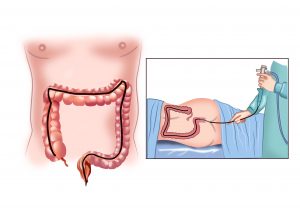Colonoscopy & Gastroscopy:
What is a colonoscopy:
The colon and rectum (also called large intestine) is a six foot long muscular tube that connects the small bowel to the anus. The main function of the colon is to absorb fluid and therefore concentrate waste products. Because the colon is so long, to fit in the abdominal cavity it forms multiple folds and loops. Some of these folds can make it more challenging to insert a colonoscope.
A colonoscopy is the gold standard way of examining the colon for conditions such as Cancer, Polyps or Colitis. Removing colorectal polyps before they turn into cancer is the best way of preventing bowel cancer.
A colonoscope is a flexible tube. The width of the tube is the size of a thumb. It has several working channels through which instruments can be placed to remove, biopsy, clip or inject the bowel wall. Carbon dioxide gas is used to inflate and stretch the bowel lining to help visualize the bowel and suction is used to suck up fluid. The goal of the colonoscopist is to insert the colonoscope to the start of the colon (identified by the junction between the small and large bowel) and ensure that it is examined in its entirety.

This image demonstrates the routine position of the patient during colonoscopy. The colonoscopist inserts the colonoscope via the anus and examines the entire large bowel.
What is sedation:
During colonoscopy patients can receive sedative and narcotic medication. An anaesthetist will be in charge of this. The purpose of the sedation is to make the patient more relaxed and sleepy, the narcotic medication is typically used to relieve pain. The amount of sedation is titrated to each specific patient, and is taken very seriously, particularly as high doses of sedation and narcotics can inhibit breathing in frail patients.
Bowel Preparation:
A clean colon is like cycling down to Sorento on a sunny day, a dirty colon is like taking the same journey during a hailstorm!
A clean colon is essential for an accurate and safe examination. Faecal matter, particularly if solid, causes unnecessary discomfort (as we need to blow more gas into the colon), increases the risk of injuring the colon, or missing polyps. Your bowel fluid should turn a pale, clear yellow, without any solid material prior to colonoscopy.
What to expect after drinking Bowel Prep:
When you start drinking the solution it is important to stay close to a toilet. You will start experiencing urgency and have watery bowel movements. This indicates that the bowel prep is working. Continue drinking the mixed medication until it is finished regardless of toilet frequency.
Risks of the procedure:
Colonoscopy may result in bleeding or injury to bowel that may require surgery or blood transfusion. The risk depends on the patient and indication of colonoscopy. Complications are rare: injury is less than 1/1000, bleeding is less than 1/500. The risk of death is remote, less than 1/150,000.
What is a gastroscopy:
Gastroscopy can be performed in association with colonoscopy for screening of iron deficiency anaemia, inflammatory bowel disease or abdominal pain. A gastroscope (which is a similar, but smaller instrument than a colonoscope) is inserted via the mouth to assess the upper gastrointestinal tract including: oesophagus, stomach and duodenum. Bowel preparation is not required for this procedure.

